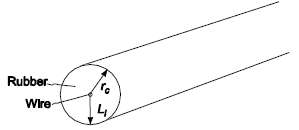The addition of insulation to a cylindrical surface, such as a wire, may increase the rate of
Question:
The addition of insulation to a cylindrical surface, such as a wire, may increase the rate of heat dissipation to the surroundings (see Problem 2.4). (a) For a No. 10 wire (0.26 cm in diameter), what is the thickness of rubber insulation [k = 0.16 W/(m K)] that will maximize the rate of heat loss if the heat transfer coefficient is 10 W/(m2 K)? (b) If the current-carrying capacity of this wire is considered to be limited by the insulation temperature, what percent increase in capacity is realized by addition of the insulation?State your assumptions.GIVENAn insulated cylindrical wireDiameter of wire (Dw) = 0.26 cm = 0.0026 mThermal conductivity of rubber (k) = 0.16 W/(m K)Heat transfer coefficient ( hc ) = 10 W/(m2 K)ASSUMPTIONSThe system is in steady stateThe thermal conductivity of the rubber does not vary withtemperature

Step by Step Answer:

Principles of heat transfer
ISBN: 978-0495667704
7th Edition
Authors: Frank Kreith, Raj M. Manglik, Mark S. Bohn





